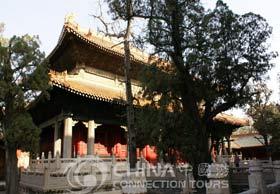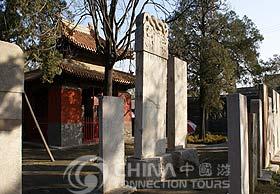 Confucian Temple, the former residence of Confucius, is the place for ancient emperors to offer sacrificial services to Confucius. Located in the center of Qufu City, the temple was originally built as early as in 478BC, one year after Confucius death. In the following dynasties, it was rebuilt and expanded many times.
Confucian Temple, the former residence of Confucius, is the place for ancient emperors to offer sacrificial services to Confucius. Located in the center of Qufu City, the temple was originally built as early as in 478BC, one year after Confucius death. In the following dynasties, it was rebuilt and expanded many times.
There are still 466 halls along three routes in the left, right and middle, pavilions and other rooms intact, covering a total area of 21.8 hectares and is 1,120 meters in length from south to north. The present one was renovated on the basis of that from Ming Dynasty. The temple was built according to the specification for imperial palaces; it is one of the three ancient building complexes in our country and holds an important position even in the world.
It covers an area of 50 acres. Inside of this complex, there are 9 yards, each among which has its own characters. The temple has an outer wall, with four corner towers, which shelters ancient pines. The main buildings along the middle route are Kuiwen Pavilion, Thirteen Stele Pavilion, Xingtan Pavilion, Dacheng Hall, Hall of Confucius' Wife and Shengji Hall.
Among them the Dacheng Palace and the Kuiwen Cabinet are its main buildings.
 Dacheng Palace is the main body of Confucius temple and is where libations and sacrifices are offered to Confucius. There are 10 poles made of marble in its front porch. Each pole has two carved flying dragons playing a big pearl. In the front of this Palace, there is a pavilion, named "Xing Chan", where Confucius used to teach in his old days. The structure of Kuiwen Cabinet is 3-layer timberwork, which is rare in our county. In Confucius temple, there is a statue of Confucius, 13 stele pavilions, 53 huge steles and 120 "Shengjitu", on which records Confucius' life experience. There are over 2,100 steles including 800-plus steles displayed outside and 1,200 existing ones, forming a Forest of Steles. The walled temple, with towers at its corners, is composed of many buildings with carved beams and painted eaves, extending for more than one kilometer from south to north. Inside the wall, ancient cypresses and pines provide the buildings with shade. The temple houses more than two thousand stone tablets with inscriptions in various styles of calligraphy. The Great Accomplishment Hall, the major structure of the temple, is 33 meters tall. It is roofed with yellow glazed tiles and has octagonal eaves. The front 10 stone columns are carved with dragons. In addition to a statue of Confucius, the hall also houses stone inscription of the Ming Dynasty, which tells the life story of Confucius in 120 pictures, as well as a great deal of stone tablets.
Dacheng Palace is the main body of Confucius temple and is where libations and sacrifices are offered to Confucius. There are 10 poles made of marble in its front porch. Each pole has two carved flying dragons playing a big pearl. In the front of this Palace, there is a pavilion, named "Xing Chan", where Confucius used to teach in his old days. The structure of Kuiwen Cabinet is 3-layer timberwork, which is rare in our county. In Confucius temple, there is a statue of Confucius, 13 stele pavilions, 53 huge steles and 120 "Shengjitu", on which records Confucius' life experience. There are over 2,100 steles including 800-plus steles displayed outside and 1,200 existing ones, forming a Forest of Steles. The walled temple, with towers at its corners, is composed of many buildings with carved beams and painted eaves, extending for more than one kilometer from south to north. Inside the wall, ancient cypresses and pines provide the buildings with shade. The temple houses more than two thousand stone tablets with inscriptions in various styles of calligraphy. The Great Accomplishment Hall, the major structure of the temple, is 33 meters tall. It is roofed with yellow glazed tiles and has octagonal eaves. The front 10 stone columns are carved with dragons. In addition to a statue of Confucius, the hall also houses stone inscription of the Ming Dynasty, which tells the life story of Confucius in 120 pictures, as well as a great deal of stone tablets.
Confucius Temple is a maze of large halls, bell towers, dragoned bas-relief columns, steles and rickety old cypresses propped up by metal joists. Nestled inside the Confucius Temple stands the famous Lu Wall - a hollow structure in which one of the Sage's descendants successfully hid his books of teachings from the emperor's troops.
